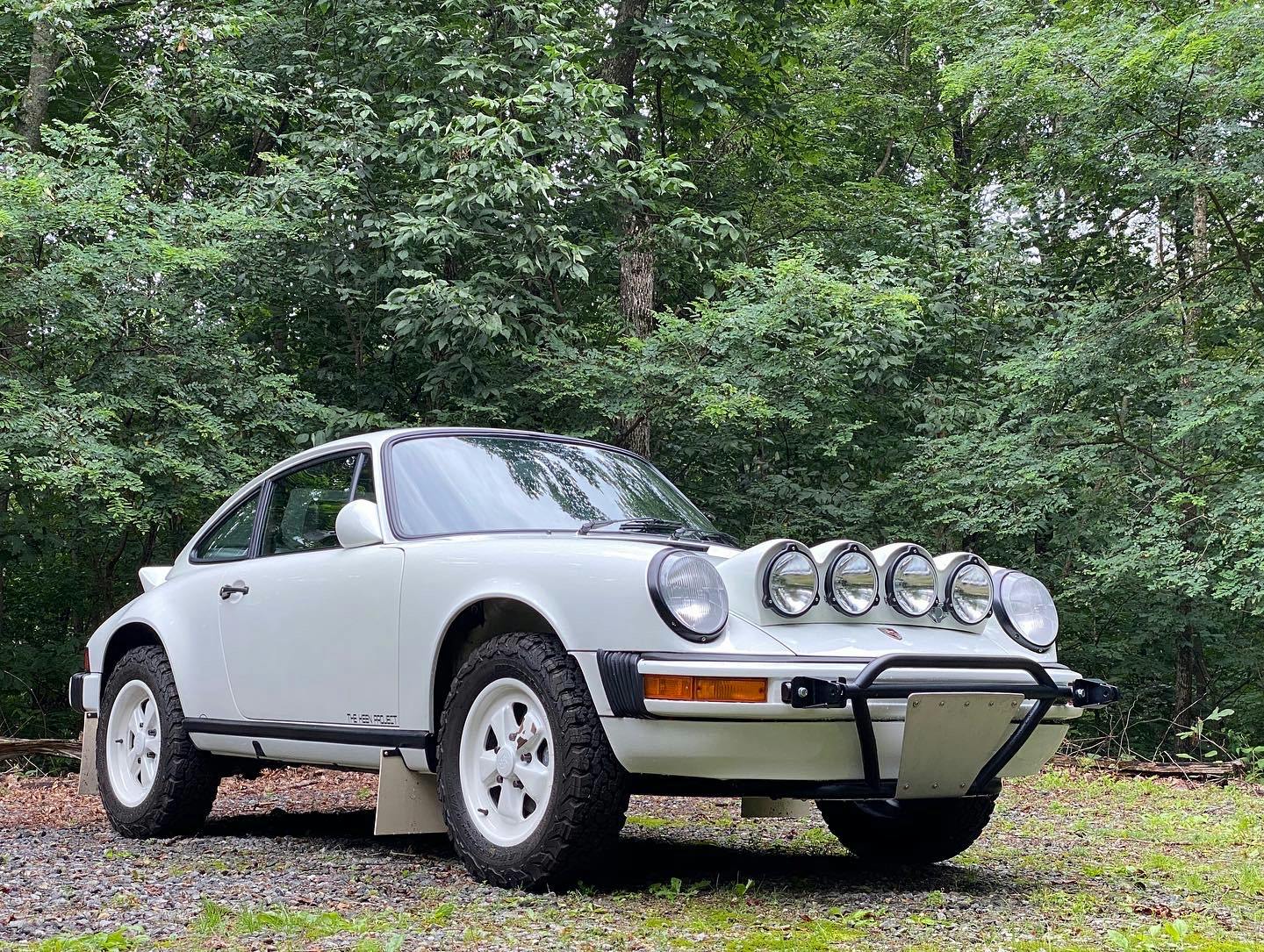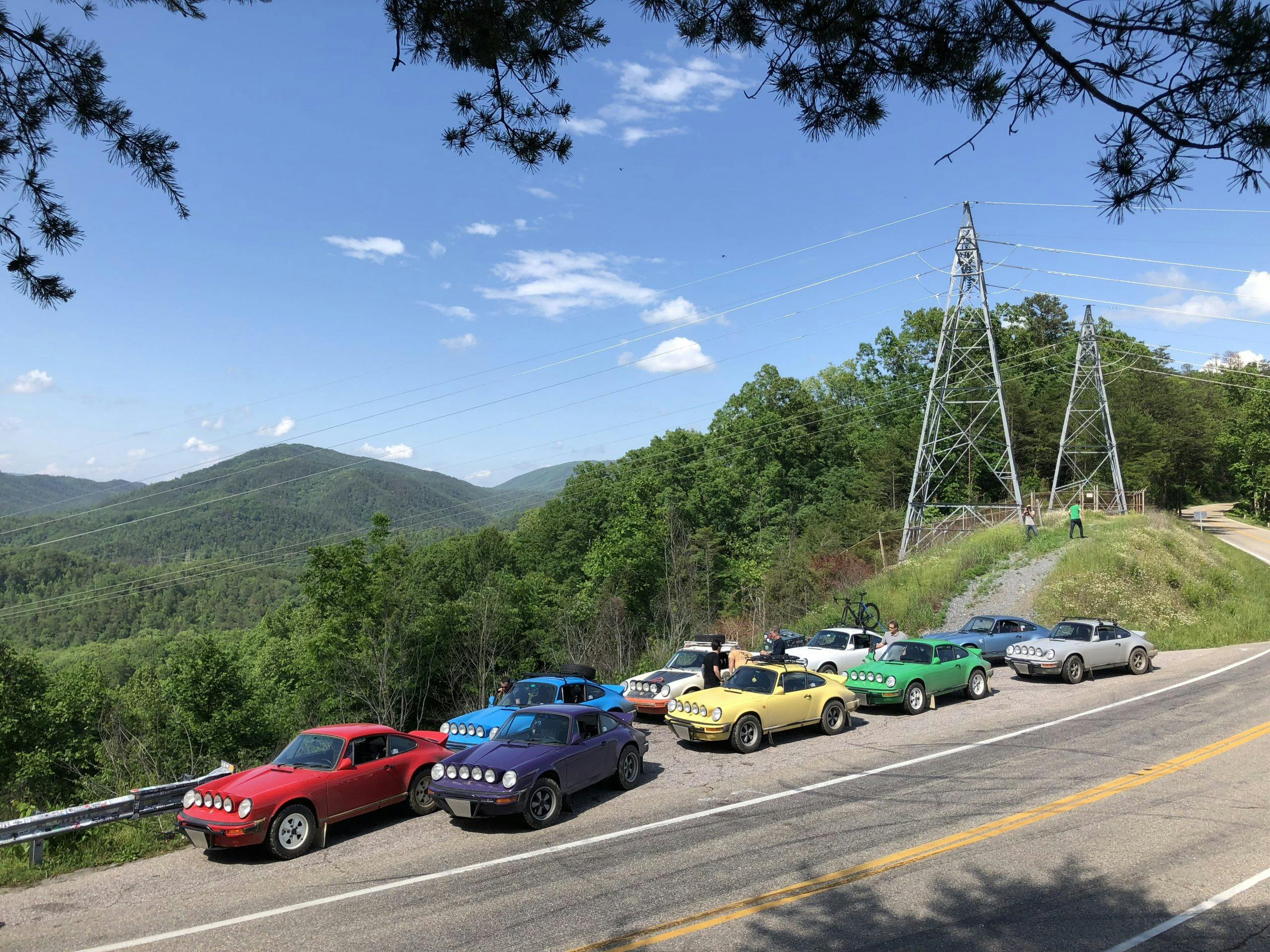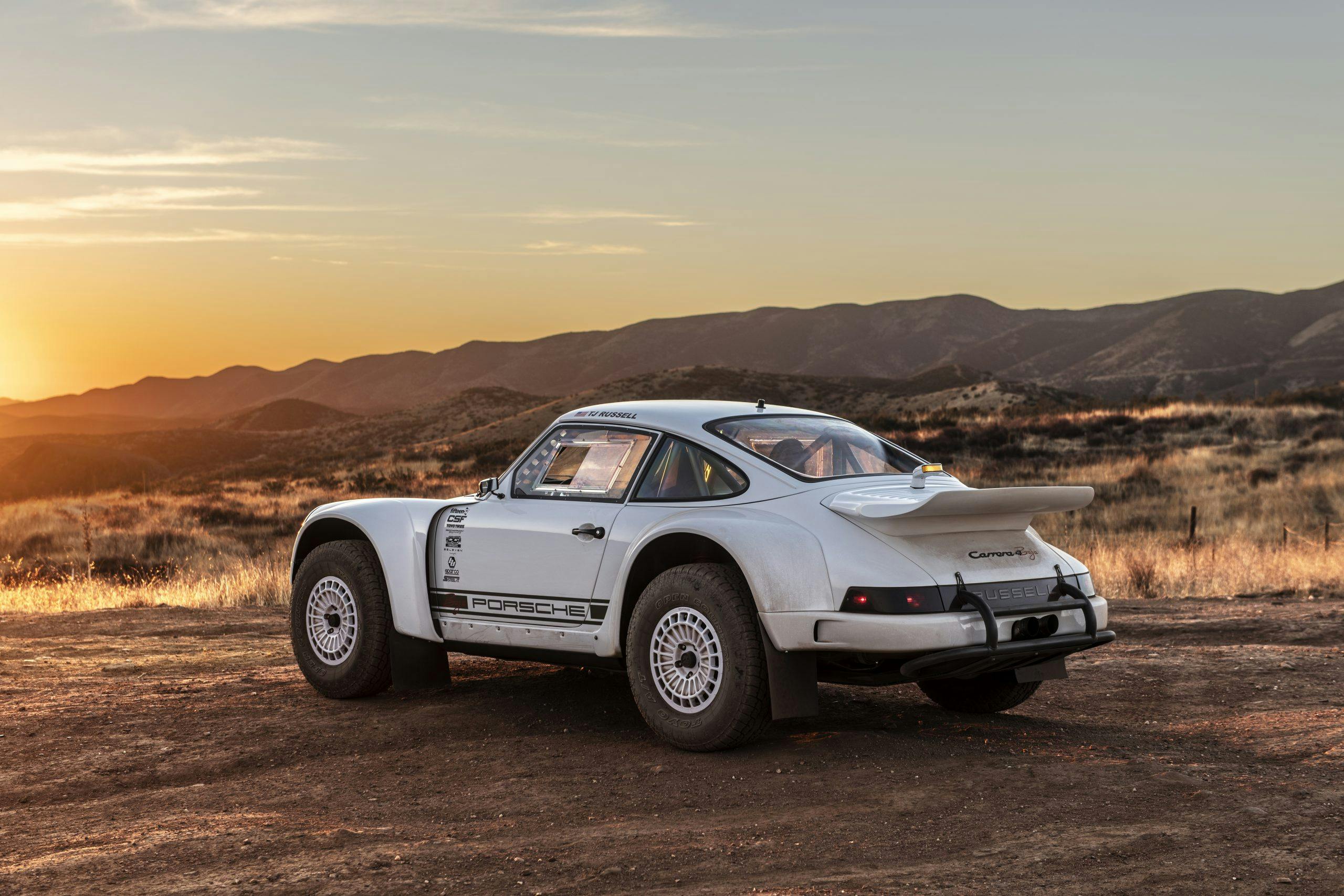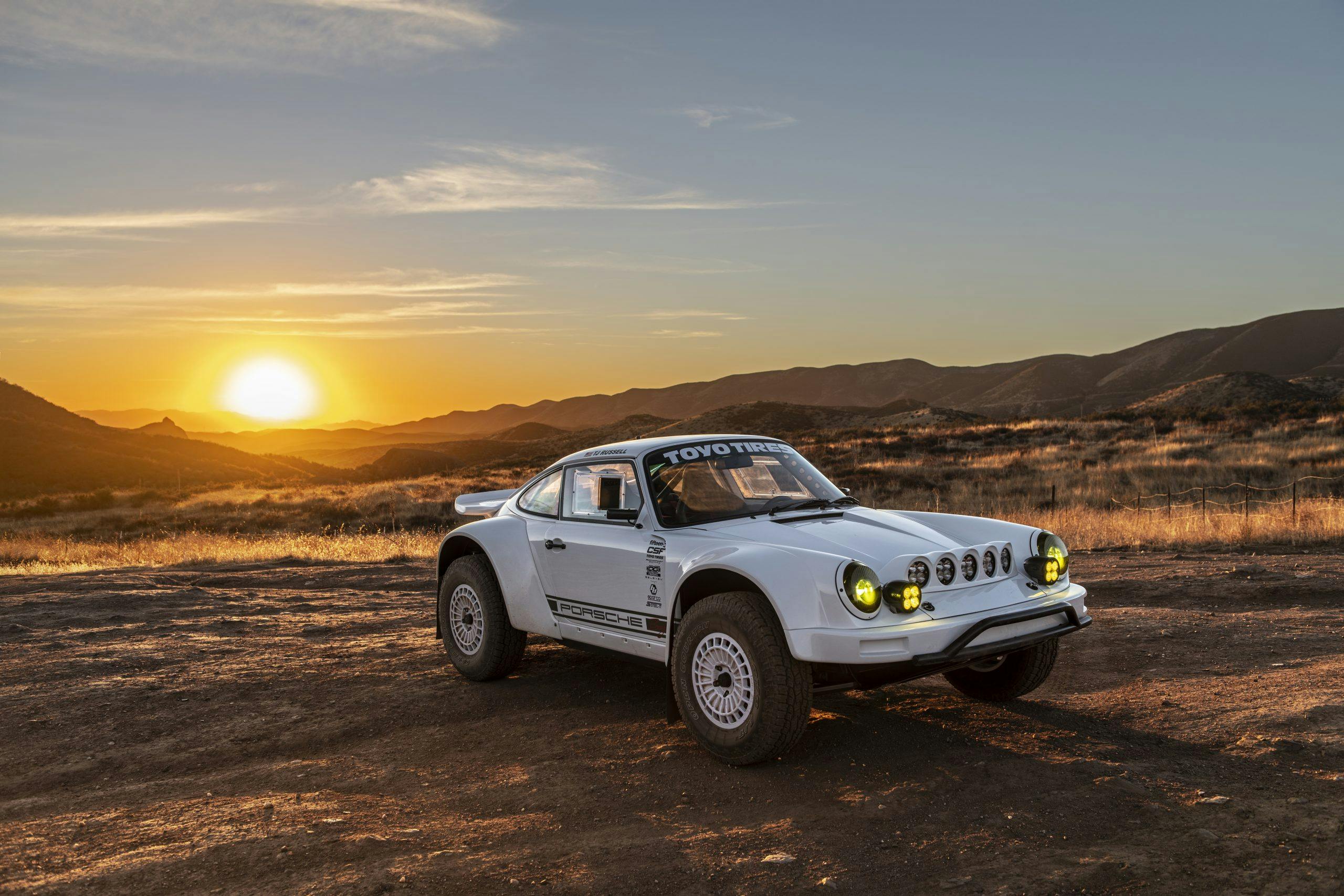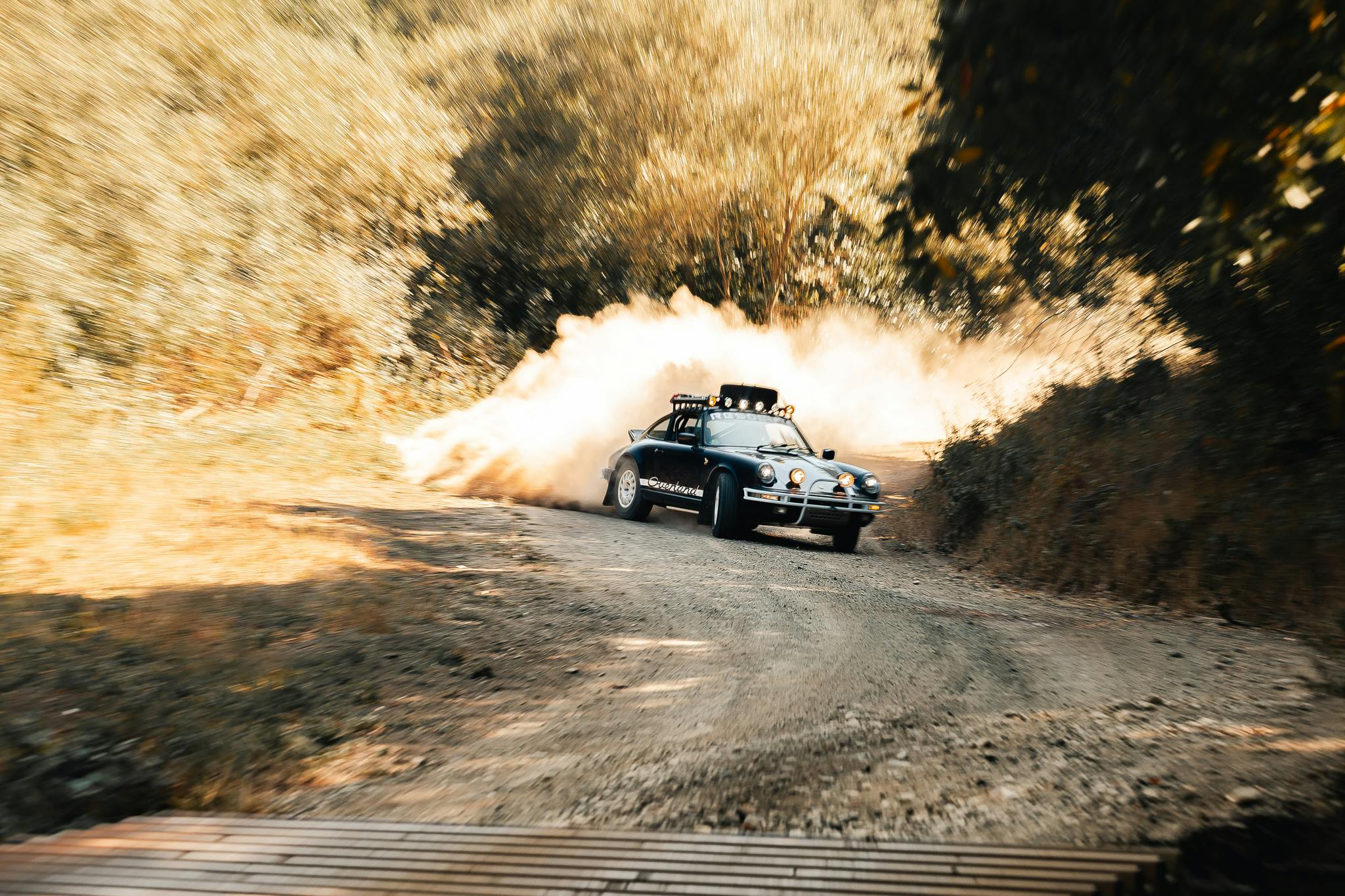Media | Articles
Porsche 911 “safari” conversions are rooted in a dirt-slinging rally tradition
You’ll find no shortage of YouTube videos showing hiked-up Porsche 911s blasting along forestry roads, desert trails, and beaches. Getting dirty, and loving it. Captured on GoPros, the drivers look giddy as 11-year-olds getting their first ride on the 128-mph, 45-story Kingda Ka roller coaster at Six Flags Great Adventure.
Welcome to the world of the “safari” 911.
Porsche owners can use readily available parts to convert their cars, or hire a specialty shop to build a custom 911 with a lifted stance, big tires, and plenty of extra front lighting. Conversions of this sort are not cheap, and that’s without accounting for the donor car. If you go the professional route for a conversion, you’ll find prices range from a bit under $100,000 to $500,000. And you may find waiting lists, too.
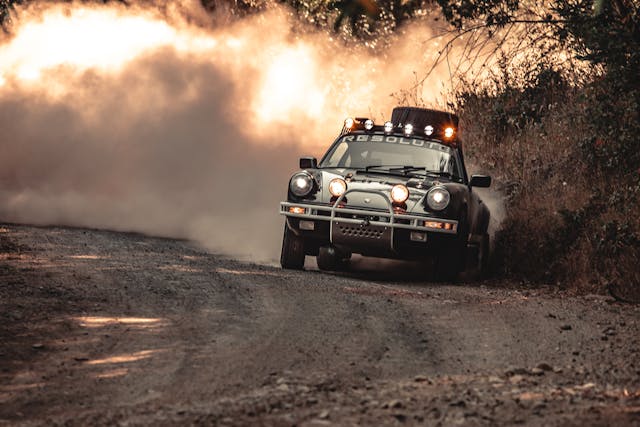
Safari: A tail-happy trend
The 911 safari aesthetic did not come out of the blue, but instead sprang from a corner of real Porsche history. The first motorsport victory for a factory-backed 911 came in the 1965 Monte Carlo Rally, with driver Herbert Linge and Porsche engineer Peter Falk scoring a class win and taking fifth overall. Their 911 was one of just 35 cars out of 237 entrants to finish the snowy 3000-mile race.
Rally drivers used the 911’s power and rear-biased weight distribution to great effect, drifting to carry speed through curves. European Rally Championships for the 911 followed in 1966, ’67, and ’68.
Marketplace
Buy and sell classics with confidence
Upping its game, Porsche in 1971 entered the East African Safari Rally, considered the world’s toughest, with a five-car team of 911 STRs. (Two were practice cars.) The 4000-mile multi-stage race took entrants over horrendous routes through Kenya, Uganda, and Tanzania. Only one of the factory 911s finished, taking fifth. (One of the two practice cars was offered in a recent Gooding & Co. online auction.)
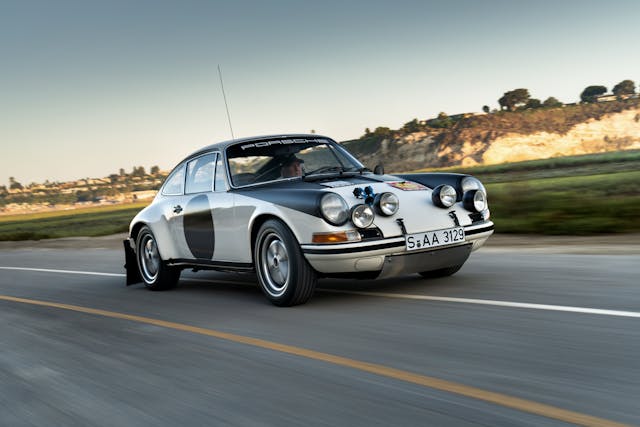
In 1984, nine of the 20 911 SC/RS models built became rally cars, most famously in Britain’s Rothmans cigarette brand livery. (An additional SC/RS was built later.) Among their many victories was winning the FIA Middle East Rally Championship. Porsche built three 4WD 911 rally cars, known as the 953, for that year’s Paris-Dakar Rally—and won. The 953’s 4WD system would be used in the Porsche 959, which took first and second in the 1986 Paris-Dakar. Originally built for the FIA Group B class that was cancelled due to its dangers, the 959 became a supercar legend.
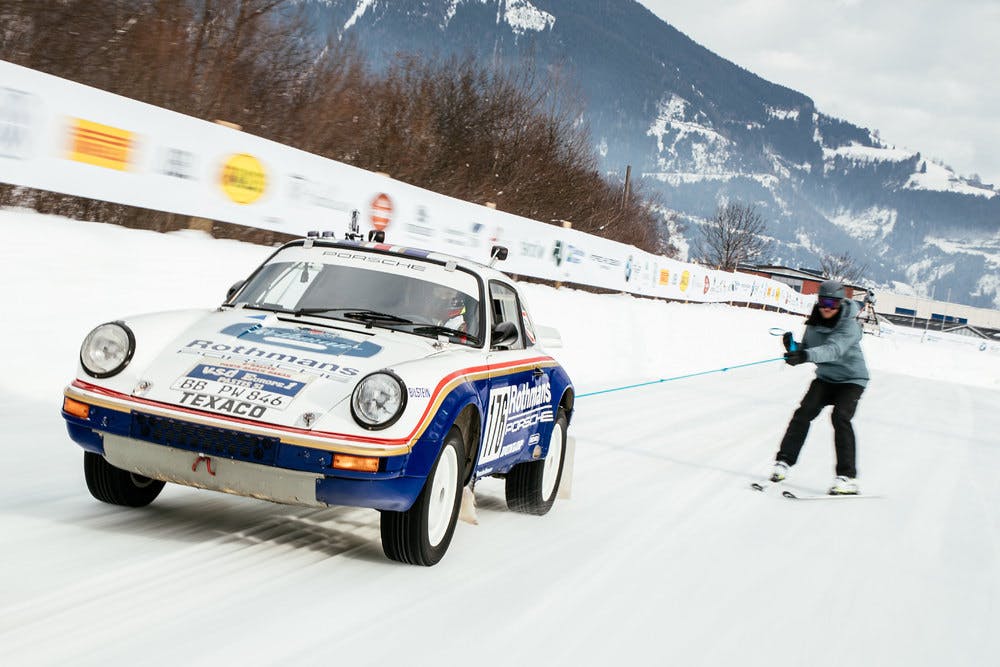
Old cars, new races
The original Safari race would become a World Rally Championship event, and the East African Safari Classic Rally was later launched in 2003 for pre-1986 two-wheel-drive, naturally aspirated cars. A 911 built by British Porsche specialist Tuthill won the nine-day, 3000-mile Classic in 2011. Appropriately, the winner was a 1971 model piloted by Bjorn Waldegård, who had won Monte Carlo twice (’68 and ’69) and taken second in the ’74 Safari driving 911s.
Tuthill-built 911s won the Safari Classic again in ’15, ’17 and ’19. (In the 1980s, company founder Francis Tuthill had prepped the Rothmans 911 SC/RS rally car body shells.) The company today offers custom safari 911 builds, including for competing in the race that inspired the name. In America, the safari trend has caught on as yet another niche for creatively modified 911s. Here’s a look at a few of the players:
Elephant Racing: The safari hardware store
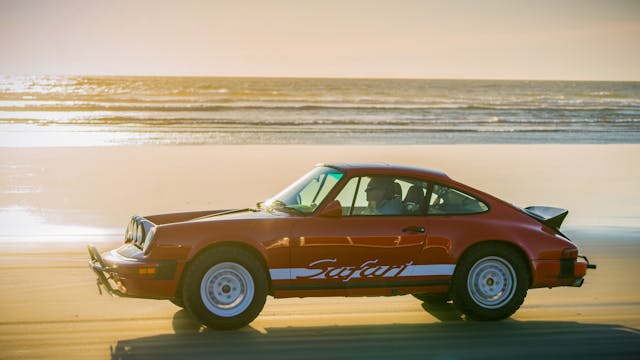
Elephant Racing made its name in Porsche road racing circles with suspension and chassis components. So, founder Chuck Moreland was quite surprised 12 years ago when a customer called asking to raise his wide-body Turbo.
“He was in the British Virgin Islands and said he wanted to turn his Turbo into a ‘rally’ car so he could drive it on the terrible roads,” Moreland recalls. “We were up for the challenge, and so he shipped his car to us.”
At Elephant’s Santa Clara, California, shop, Moreland found a way to raise the car while avoiding suspension geometry problems. Elephant has built a few other conversions and has sold safari packages for more than 100 cars.
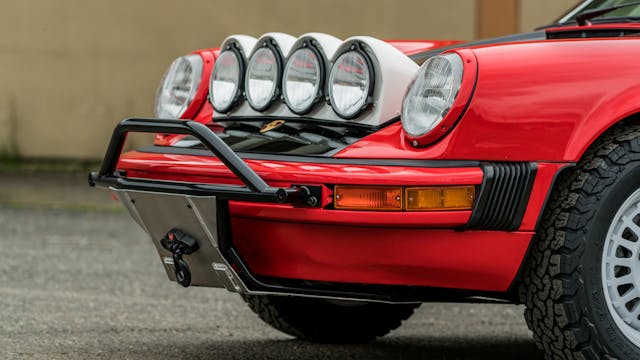
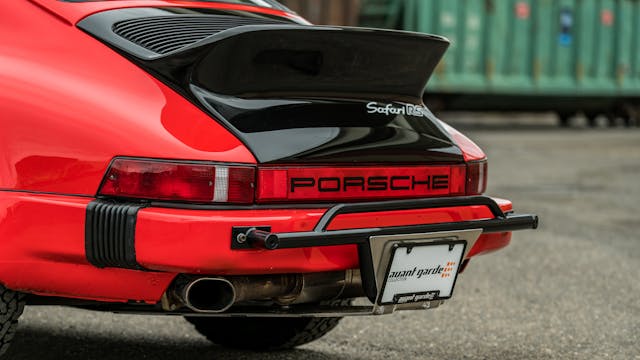
One customer was Avant-Garde Collection, a high-end car dealer and Porsche specialist shop in Portland, Oregon. A 1983 911 SC the shop turned into what it called a “Safari RS” was sold on Bring A Trailer to Erik Swan for $142,000. In addition to Elephant full coilover suspension, the A-G car features 16-inch Braid wheels with BFG All-Terrain tires, skid plates, a TRE light pod, Warn winch, and the classic Porsche “Pasha” (checkerboard) upholstery.
“He drives it a lot on dirt roads and sends us photos of the car going through creeks,” says Avant-Garde Collection owner Matt Crandall.
Notably, Elephant offers safari chassis kits for all 911 generations except the new 992. Elephant has even built a safari Cayman. Kits include special weld-on reinforcements designed from Elephant’s experience exposing the 911’s weak points in road racing. To return the car to stock, the bolt-on suspension parts can be removed. The added reinforcements, which do not affect ride height, can remain in place.
The Leh Keen Project: Into the woods

Another Elephant customer, and one that Moreland credits with popularizing the safari niche, is successful Porsche road racer Leh Keen. In 2016, he built a 911 safari to enjoy at his southern mountain retreat. When he let friends sample the car, he suddenly found himself in business.
“The first person to drive my car bought one,” says Keen, who calls his enterprise the Leh Keen Project. “We just delivered our twenty-third car in early August. We have six under construction and orders for 40 more.”

Keen specializes in converting 1980s Carrera 3.0 and SC 3.2 models. He emphasizes, however, that these are built for loose surfaces, gravel trails, and dirt roads, not racing. Each customer car is first brought up to snuff with a refreshed engine and transmission, along with some minor performance tweaks. High power is not needed.
“You’re not going very fast with this kind of driving,” Keen explains.
The cars get one of Elephant Racing’s torsion bar suspension packages, along with special long-travel shocks from Motion Control Suspension. Skid plates are installed, and the brake bias is moved rearward for lower-grip surfaces.

The rally look is functional, with bumper bars, a light pod and mud flaps. The 935-style mirrors slim down the car for narrow trails. Most cars are built to similar specs for about $90,000-$100,000 on top of the 1980s donor 911 that Keen says might cost $35,000–$45,000.
Forget about the classic 911’s propensity for snap-oversteer, too, Keen explains.
“On loose surfaces, it’s more of a controlled rotation. You slide but you don’t spin. I have customers who had zero experience with this kind of driving, and within one or two hours, they were drifting through corners.”
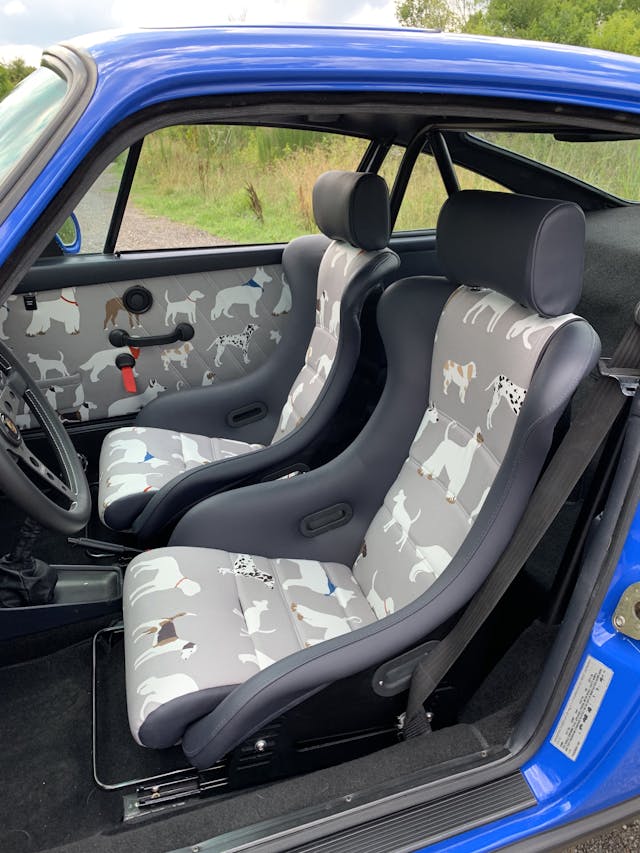
Keen’s 911 safari interiors have drawn attention for the almost whimsical patterns. The wild-looking fabrics use some classic Porsche colors.
“I felt that if you were going to do this to a 911, you should get funky with the interior,” he says.
Resolute Motorsports: Going for hardcore

Being headquartered in Jackson Hole, Wyoming, Resolute Motorsports founders Gal Bar-or and Scott Birdsall wanted to offer customers a 911 that could handle the pounding that Northwest weather and forestry roads can dish out. They call the Overland; they don’t like the “safari” label.
“The Overland is a real off-road machine,” says Bar-or, whose diverse background includes building and flying bush planes. “It’s not quite a Baja car, but you could run a rally.”
Resolute focuses on converting 1983–1989 models. To build an Overland, the entire car is gutted and essentially remodeled, with an Elephant Racing coilover suspension conversion that includes new sway bars, Turbo tie rods and reinforcements on all critical points. Engine output is bumped up a bit to 225 hp.

A complete new interior includes leather seats, a roll bar, and four-point harnesses. Rally wheels, off-road tires, and full bumper-to-bumper under-car protection make the Overland ready for rugged trails. In a nod to rally heritage and driving thrills, the Overland comes with a drift brake.
“It’s just clutch-in and touch the drift brake, and the rear end comes loose,” says Bar-or. “Then just gently add power to put the car into a controlled drift. Customers love it.”
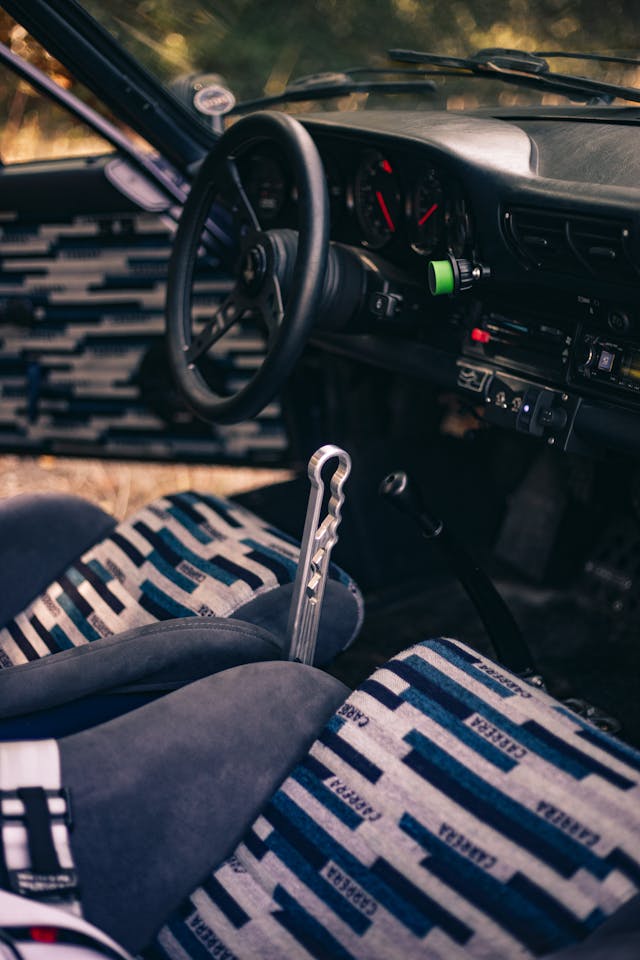
A Stage 2 option gets a specially built 320-hp twin-plug 3.4-liter engine, a rebuilt transmission and differential with custom gearing, and more. Stage 3 replaces all stock electrics with MilSpec wiring and full MoTeC electronics package. All body holes are sealed to block water and dust. Conversion prices range from $85,000–$220,000 to start, with more options available.
“Our customers want a fun car they can take out on forest trails, hit bumps or rocks at speed and not worry about damage,” says Bar-or. “But it’s still quite capable on regular roads and not too loud or unrefined.”
Rothsport Racing: Baja winners
Let’s say you want to take a 911 really far off the beaten path, where the “roads” are sometimes just the tracks carved in the desert surface by vehicles traveling ahead of you. Think Mexico’s Baja California peninsula.
Jeff Gamroth, founder of Rothsport Racing in Sherwood, Oregon, has been road-racing Porsches since 1987 in SCCA, IMSA, and Porsche Club competition. Looking for a new challenge, he built a pair of 964s—one for himself, the other for customer Cameron Healy—to race in North American Off-Road Racing Association events in Baja. His first attempt in the NORRA Mexico 1000 in 2016 ended with a DNF.

“We didn’t have enough ride height, and the tires were too small,” says Gamroth. “We got stuck about 20 times, but we learned a lot.”
Returning to Baja better prepared in 2017, he took fourth in class, and Healy took third (out of eight entries). In 2018, Healy won class and Gamroth took second, and they reversed that order in the 2019 NORRA 500. Hot Rod Films chronicled their adventures in two short films, “1,000 Ways to Fail” and “Icarus.”
The Rothsport cars have 11 inches of ground clearance using 29-inch BFG All-Terrain tires. The 3.6-liter engines are basically stock “with a slight tune,” giving 325 horsepower. Gamroth says the 911’s rear trailing arms work well in Baja but that the MacPherson strut front is the weak link. Rothsport uses its own custom lower control arms and “trick shocks” from England.
“We reinforced the front to take the hits. I can hardly describe how rough it can get,” he says.
The Rothsport cars wear more than 100 pounds of skid plates made from quarter-inch 6061 aluminum plate. Over that goes a heavy-duty composite that helps the car slide over bumps, rocks, and other obstacles.
“In Baja, there’s every surface you could imagine,” says Gamroth. “It can all go wrong quickly, and your race is over. But it’s an adventure. I love it.”
Think you might love it, too? Rothsport is currently building a third Baja 911 racer to sell.
Russell Built: “Luxury prerunner”

Maybe you’d like a 911 that could run a desert race but still be used on the street. That’s the basic idea behind the Baja 911 crafted by T.J. Russell. After doing fabrication for Singer Vehicle Design for nine years, he decided to design and build a 911 that could play in the SoCal desert like his ATVs and side-by-sides. Russell’s 964-based dual-purpose machine was one of the 2019 SEMA Show brightest stars.
“My idea was to imagine if Porsche had kept growing its off-road program after 1989 and built a car for Baja,” says Russell. “What would that look like? What kind of suspension would it have?”
Supposing what Porsche’s racing department might have done, he reinforced the 911 shell and modified it for ground clearance and safety. The front bulkhead, for example, is sealed off from the fuel cell, a racing requirement. There’s a full racing-spec rollcage, and the car is sealed from dust intrusion.

Russell makes his own differentials and many other parts, while subcontracting some machining and composites. His A-arm suspension uses custom spindles, adjustable coilover shocks and NASCAR-style sway bars. Combined with the Toyo Open Country AT II tires on Fifteen52 Integrale wheels, there’s 13 inches of ground clearance.
The standard 3.8-liter and 4.0 liter upgrade engines come from Rothsport Racing. The 3.8 makes about 365 horsepower and teams with a 996 Turbo manual transmission. The first car started from a C4 and retains the all-wheel drive, but customers can opt for 2WD, too.
The Baja 911, which Russell describes as a “luxury prerunner,” shows serious off-road intent with Recaro SPX seats in quilted Alcantara, a MoTeC digital display, Sparco racing harnesses and control knobs to adjust brake, torque and differential bias.
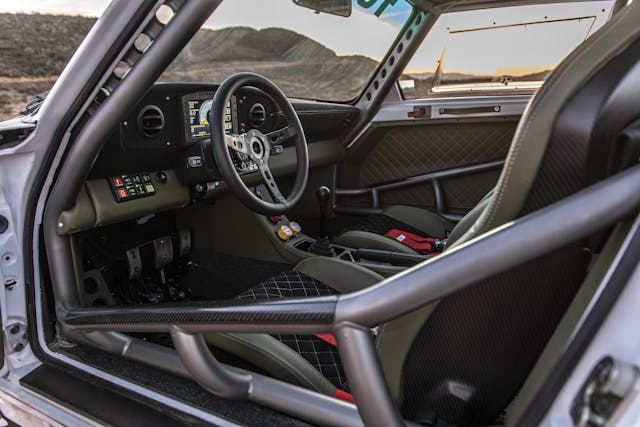
“It can be a daily driver, and you could also go out to the desert for a camping trip or into the mountains,” Russell says. “I ran about 50 laps at Homestead in Miami. It’s still a sports car.”
Russell plans to build just four cars a year, priced around $500,000. He’s also working on a 993-based version.
Desert footnote: Who Were “Max” and “Petunia?”
Porsche once built its own street-legal 911 desert runners—sort of. Twenty years ago, Porsche Cars North America outfitted two C4s with raised suspension, off-road tires, and skid plates and sent them across California’s Mojave Desert and to the North Rim of the Grand Canyon. The cars were nicknamed Max and Petunia.
Porsche used the stunt to draw attention to its all-wheel drive and also its support of a trail-restoration initiative ahead of its Cayenne SUV launch. One of the drivers was actor James Brolin, who also served as the trail project’s spokesman.
PCNA returned the cars to stock, made necessary repairs and sold them. Unfortunately, a company spokesperson informs Hagerty that photos from Max and Petunia’s excellent adventure seem to have been lost.
Anyone have Brolin’s phone number?









